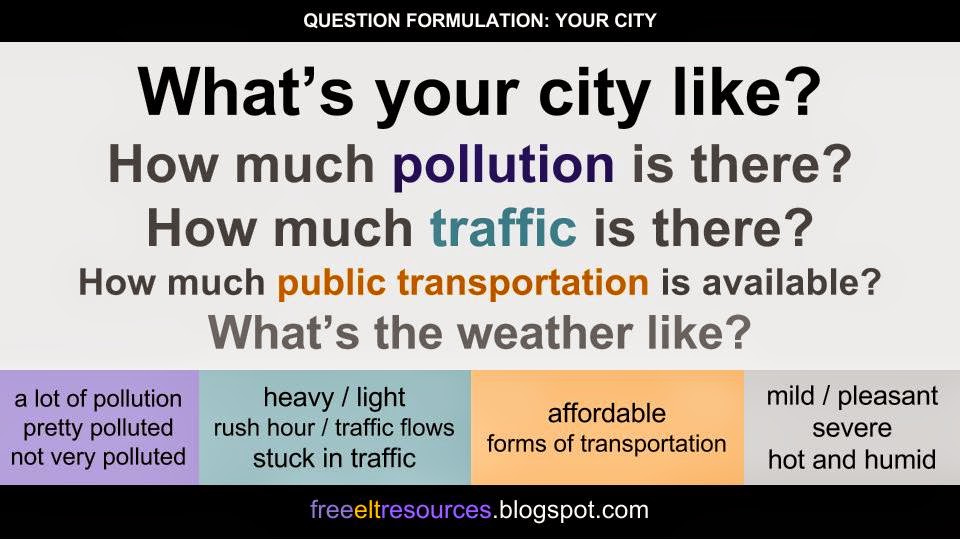QUESTION FORMULATION: Your City
LEVEL: 180 - 210
¿Puedes contestar las preguntas usando el vocabulario sugerido?
LAS SIGUIENTES RESPUESTAS FUERON DONADAS POR CHRISTINE BORSERIO. Parte del siguiente texto será eventualmente traducido.
- My city is situated on the Timor Sea and has a huge natural harbour. It is one of the most modern in the country, having been almost entirely rebuilt in 1974 after being devastated by a cyclone.
- There is virtually no pollution, as the main industries of the area are mining and tourism. The mining is far from the town and most energy production is off-shore.
- The population is just over 136,000 and most households have at least one car. Roads are well-maintained and traffic is monitored by a regular police presence and road safety advertising campaigns. The heaviest flow of traffic is the hour before work begins and at the end of the working day, which also lasts about an hour.
- The city has a good bus network, as buses are the main mode of public transport and are operated by the state government. The fleet is maintained to a high standard and most buses are air-conditioned for passenger comfort. There is no commuter rail system; although a long distance passenger rail service operates out of the city.
- The city has a tropical savanna climate with distinct wet and dry seasons. Average high temperature is 32C and low is 19C; although high of 35C in the wet season and low of 15C in the dry season is not uncommon. The dry season is May to September. December to March are the wettest months, with afternoon humidity of over 70%. Violent thunderstorms are common and cyclones also threaten the area in the wet season.
- The dry season weather is pleasant, with daily sunshine from April to November; so it is during this time that tourism is at its peak.
LAS SIGUIENTES RESPUESTAS FUERON DONADAS POR KEN BORSERIO. Parte del siguiente texto será eventualmente traducido.
- In my home city Darwin, which is located on the coast of north Australia, there is not much pollution. This is perhaps due to the size of the city, around 136,000 people; so there are not as many cars on the roads. The industry is light industrial and is located on the outskirts of the city.
- Dual and tri-lane highways move traffic efficiently and smoothly in and out of the centre thus you do not find yourself stuck in traffic for long periods of time. During “rush hour” times, it may take you an extra 10-15 minutes to reach your destination, depending on where you are travelling too.
- There are no trams or trains in Darwin but there are large buses and also kombi-vans that can be used for a large number of people. The costs are reasonable and affordable.
- Taxi fares are calculated by a meter installed in the cab and charge according to distance travelled. Fares are thus very expensive, so the local people will avoid using taxis and car pool instead.
- The weather is hot all year round, averaging 14 degrees to 34 degrees Celsius. The climate is tropical and divided into two distinct seasons, the “wet” and the “dry” season. For two months, either side of these periods the weather is hot, humid and unpleasant.
- Between the end of the dry season and the start of the wet season, which is late October through to early December, the weather is deemed to be the cause of an abnormally high number of suicides. As this is also the time when mango trees are fruiting, this time is known locally as “mango madness”.
¿Más vocabulario y ejemplos? Sigue estos enlaces:







Comments